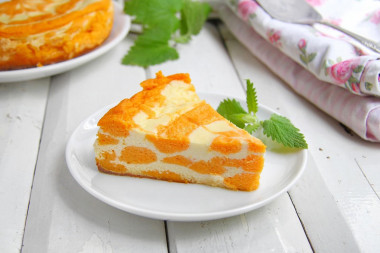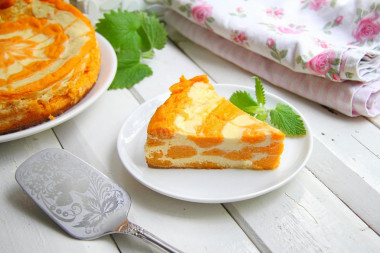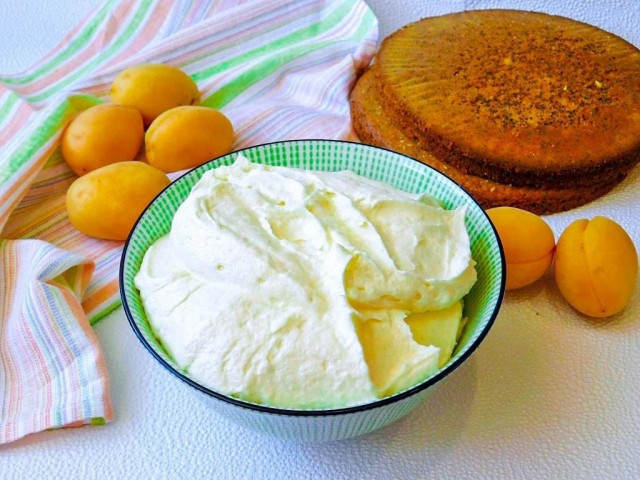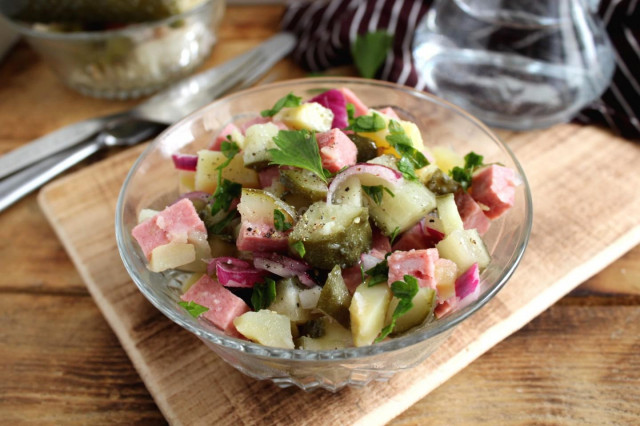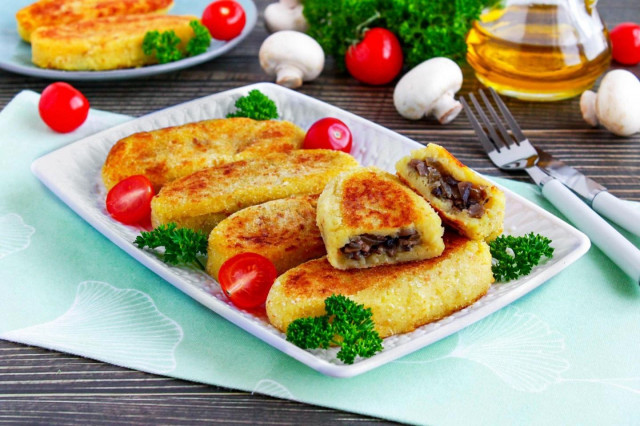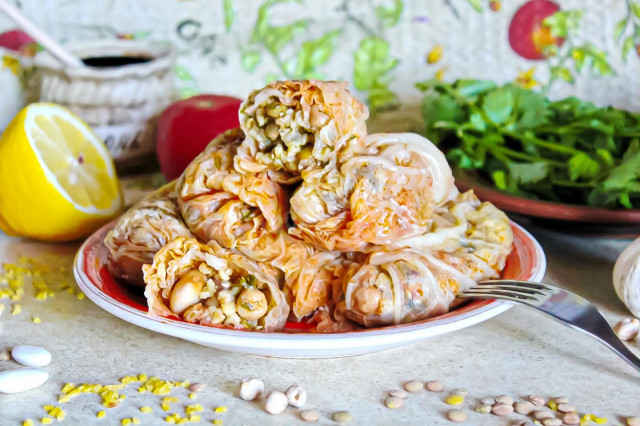Composition / ingredients
Step-by-step cooking
Step 1:

How to make a cottage cheese casserole with pumpkin in the oven? Pumpkin for casserole choose juicy and sweet, I have a variety of "Butternut". Wash the pumpkin under running water, peel and grate on a coarse grater. Transfer to a saucepan and pour in the water. Simmer over low heat, stirring occasionally, until tender for about fifteen minutes. Instead of cooking, you can bake pumpkin in large pieces in the oven, but cook faster.
Step 2:
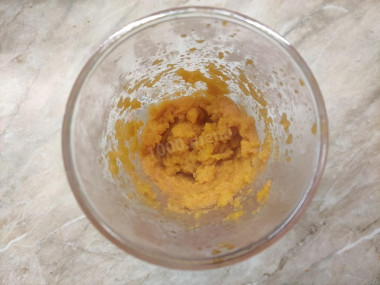
Transfer the pumpkin to a tall glass of a blender and whisk with an immersion nozzle until smooth. Put the mashed potatoes aside for now.
Step 3:
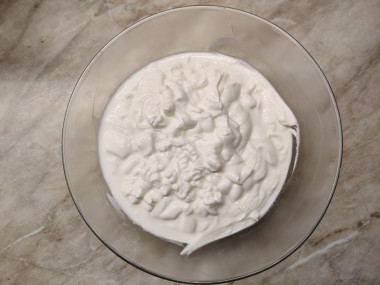
Don't take the cottage cheese dry! Cottage cheese in rectangular briquettes is ideal, or as I have - in a soft sausage package, from which the cottage cheese is squeezed out by hand through a hole. Put the cottage cheese in a bowl.
Step 4:
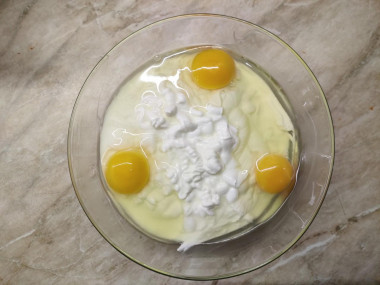
Beat in the same eggs.
Step 5:
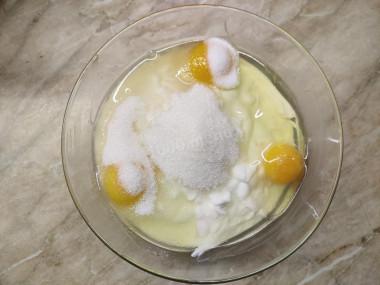
Add salt, plain and vanilla sugar.
Step 6:
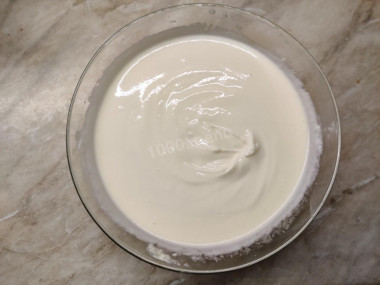
With a mixer, mix the cottage cheese into a single substance.
Step 7:

Now we have to divide the curd mass into two parts: white and orange. In a separate bowl, transfer all the pumpkin puree and 300 grams of cottage cheese from the first bowl.
Step 8:

Mix the pumpkin-curd mass (due to the addition of puree, it will become more liquid than white), and add so much flour to it that the density of the white and orange mixtures is approximately leveled. I added two tablespoons, but look at the consistency. Do not add flour to the white mixture!
Step 9:
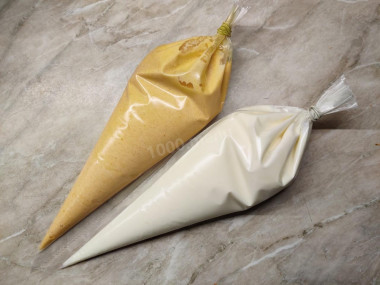
Transfer the cottage cheese into two different cornets (pastry bags). The long ends can be secured with elastic bands and then cut off.
Step 10:

Grease the baking dish with butter. I have silicone with 18 cm in inner diameter, the rim is 5 cm. At the cornets, cut off two centimeters of sharp soldered tips and carefully distribute the cottage cheese in rings, alternating colors, starting with the largest - the outer one. As soon as the first layer is completely filled with multicolored rings, we proceed to the second, in a staggered order. That is, you need to try to lay the white circle over the orange one, and the orange one over the white one.
Step 11:
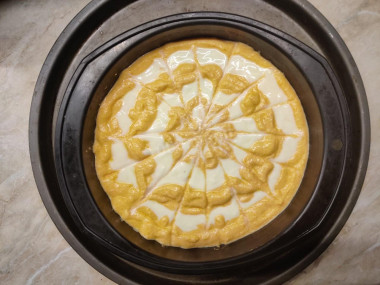
Work according to this scheme until you run out of all the cottage cheese. I got three layers of multicolored circles. If desired, you can make a pattern on the surface. With a toothpick, draw several rays from the center to the edges, and then, between the rays, in the same way, but from the edges to the middle. Bake the casserole until the cottage cheese is stabilized and the top is lightly browned for about an hour in a preheated oven to 150 degrees. The time may vary greatly.
Step 12:

In any case, the casserole should rise well and become elastic not only at the edges, but also in the middle. After the casserole is ready, turn off the oven and leave the mold inside to cool gradually for about twenty minutes. So the casserole will lose a minimum of its volume.
The casserole turns out to be airy and very tasty, with a rich pumpkin flavor and a slight hint of vanilla. It is elastic and soft due to eggs, even small bubbles can be seen in the photo, although we did not beat the eggs especially. The fragrance is so cozy and autumnal, beyond praise! And for the bright coloring, my family nicknamed her "Beautiful casserole" :)
Don't let the use of cornets frighten you! It's much faster than half an hour to spread the same "zebra" with spoons… With cornets, the main thing is to observe the order of overlapping circles so that white does not appear above white, and orange above orange.
If suddenly, having already laid out the cottage cheese in the cornets, it became clear that one mass is thicker than the other, it's okay! First, make the circle thicker, and fill in the gaps with a more liquid mass.
Note that cottage cheese dishes are quite capricious and not the easiest thing to prepare. A lot here depends on the quality of raw materials.
I strongly recommend using kitchen scales in work.
Bon appetit!
Keep in mind that everyone's ovens are different. The temperature and cooking time may differ from those specified in the recipe. To make any baked dish successful, use useful information about the features of ovens !
How to bake a lush and tender casserole? Do not expect the same increase in volume from the curd mass, as, for example, in a yeast cake or sponge cake. The splendor of the curd casserole directly depends on the size of the chosen shape: the smaller the shape and the higher the sides, the higher the layer of curd mass for baking will turn out, which means the finished casserole will be higher.
Important! In order for the curd dough or filling to be successful, it is important to carefully consider the choice of cottage cheese. A low-quality product can spoil baking, as it directly affects the consistency, taste and final result. How to choose the right cottage cheese for dough or filling, read in this article .
Caloric content of the products possible in the composition of the dish
- Chicken egg - 157 kcal/100g
- Egg white - 45 kcal/100g
- Egg powder - 542 kcal/100g
- Egg yolk - 352 kcal/100g
- Ostrich egg - 118 kcal/100g
- Pumpkin - 29 kcal/100g
- Cottage cheese of 40% fat content - 466 kcal/100g
- Cottage cheese of 20% fat content - 233 kcal/100g
- Cottage cheese of 18% fat content - 226 kcal/100g
- Cottage cheese of 10% fat content - 156 kcal/100g
- Low-fat cottage cheese - 75 kcal/100g
- Cottage cheese with sour cream - 260 kcal/100g
- Fruit cottage cheese - 147 kcal/100g
- Soft dietary cottage cheese - 170 kcal/100g
- Vitalinia cottage cheese - 64 kcal/100g
- Cottage cheese "morning" ( "danone") without sugar - 91 kcal/100g
- Cottage cheese - 156 kcal/100g
- Whole durum wheat flour fortified - 333 kcal/100g
- Whole durum wheat flour, universal - 364 kcal/100g
- Flour krupchatka - 348 kcal/100g
- Flour - 325 kcal/100g
- Granulated sugar - 398 kcal/100g
- Sugar - 398 kcal/100g
- Vegetable oil - 873 kcal/100g
- Salt - 0 kcal/100g
- Water - 0 kcal/100g
- Vanilla sugar - 379 kcal/100g


